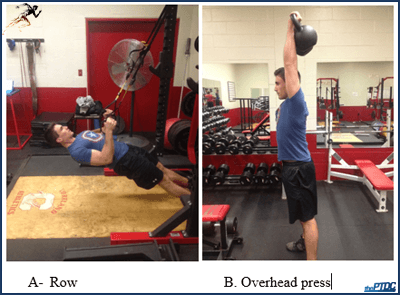Great coaching boils down to picking the most effective exercises for the client and saying the right words at the right time to invoke the desired results.
If two coaches set out to cue the same client on the same exercise, the one that presents information about the movement in an optimal way is going to be the most successful.
There are three considerations every trainer needs be aware of while coaching exercises. These include
- Exercise selection
- Presentation of information
- Quantity / frequency of cueing.
Selecting the difficulty of an exercise
For this section we presume two things, (I) it's the responsibility of the personal trainer to help their client learn new exercises; and (II) once learned, the trainer works to improve performance (in terms training volume) in the exercise.
The trainer works to improve performance through progressive resistance training because it's going to help their client reach their goal of fat loss, muscle growth/ endurance, or increased strength.
Because the client is learning new exercises, the movement the trainer introduces should be sufficiently challenging. This isn't to be taken as a jab at machine-based or single-joint movements. However, these exercises are fairly easy to learn and likely could be done without the aid of a trainer.
On the other hand, the movement shouldn't be so challenging that performance is poor. For example, a leg extension may be easily learned (although the potential for further learning is low) and performance (in the context of good form) will be high for many people.
The opposite scenario occurs with a back squat. The client has a lot of potential for learning because it's a new and challenging movement but because it is complex performance will be low. It's the trainer's job to select an exercise where the client has good potential to learn with initially decent, but not necessarily perfect form.
Here's a great example of cues for teaching the back squat (Note: This video is NSFW (Not Safe For Work. There is also profanity so if that offends you, skip it)
How to do a SquatA lot of people have lost the ability to do the squat because we live in modern times.That means that we spend a lot of time sitting in chairs, riding on subways, and j**rking off to online porn.=================This video is property of Mark Fisher Fitness and is used with permission. Learn More about Mark at www.markfisherfitness.com and subscribe to him on YouTube at www.theptdc.com/markfisheryoutube and follow him on Facebook at Mark Fisher Fitness.
Posted by Personal Trainer Development Center on Sunday, February 15, 2015
*for further reference read "Challenge point: A framework for conceptualizing the effects of various practice conditions in motor learning"
Presentation of information
Let's look at the squat exercise; you might cue your clients (as I have also done in the past) by saying:
- Hips back
- Bend your legs
- Knees out
- Back flat
All these cues have one thing in common -- they all drive the client's focus of attention internally.
Internal cueing guides the client to focus on the movements their body is producing (i.e bend the legs, flex at the hips). Another form of cueing helps the client to focus externally. External cueing directs the client's focus on the result of the movement (i.e. squat down to the box). While the research on focus of attention and learning resistance training movements is nonexistent1 the evidence in sporting skills favors external cueing over internal cueing.
The constrained action hypothesis provides a rationalization for why external cueing is more effective than internal cueing. It states that an internal focus interferes with automatic control processes that control the movement. An external attentional focus does not interfere with this automatic control process.
Because external cueing is more effective than internal cueing the trainer should think of ways in which he or she can relay information in such a way.

*coaching exercise: think of ways you can cue these exercises by driving the focus of attention externally*
Of course there will be some instances when the client may need to draw their attention internally. If the goal is to increase muscle size then it's reasonable for the client to focus on the muscle. Further during exercises such as the deadlift the trainer may need the client to feel that their lats and spinal extensors are working to help brace their back.
However, if you're clever you can certainly find ways to get your client to activate their lats without saying "brace your lats." Tony Gentilcore, in a blog post entitled "The 7 Habits of Highly Effective Deadlifters" provides a great example:
"1. Squeeze an orange in your armpits
2. Protect your armpits.
3. Phew...your armpits stink.
4. Put your shoulder blades in your back pocket.
All are fantastic external cues to help people get the lats to fire to provide more tension and thus, stability. Despite this, some people may still look at you as if you're speaking Elvish when you tell then to "turn on" their lats." - Tony Gentilcore
Also in the context of weight lifting the use of analogies and metaphors (i.e. the orange example in Tony's post) are excellent ways to draw attention externally.
Here's PTDC coach Dean Somerset explaining the exercise with good cueing
Breaking Down the DeadliftInteresting anecdotal story:Years back a Roman general needed to figure out a way for his young soliders to stop getting hurt clearing away dead bodies from the battlefield.As the story goes, he taught them proper lifting technique, and the deadlift was born. So yes, the name literally comes from learning how to lift the dead.55 Reasons Why the Deadlift is the Best Exercise of All Time here: http://www.theptdc.com/2014/02/deadlift-exercise/**********This video is property of Somerset Fitness & Marketing, LLC and is used with permission. Learn More about Dean Somerset at www.deansomerset.com and subscribe to him on YouTube at www.theptdc.com/deanyoutube
Posted by Personal Trainer Development Center on Tuesday, February 3, 2015
1 External focus of attention seems to be beneficial for higher torque production due to an increase in movement economy.
Quantity of information presented / frequency
Let's imagine what a coach might say for two cueing scenarios of a goblet squat:
- Scenario 1: "Squat"
- Scenario 2: "Push your hips back and bend at your knees. While you're squatting down push your knees out so they aren't coming any closer to touching each other. Keep squatting until your thigh is parallel with the ground. Make sure that your heels stay on the ground as well. When you're thigh is parallel with the ground forcefully extend your hips and your knees until you're standing back up. Also, breathe in at the top of the movement and breathe out as you finish the movement.
Scenario 1 presents too little information for learning to occur. While "squat" may be the only thing a skilled mover needs to hear to complete the movement, this won't provide enough information for a beginner.
Scenario 2 on the other hand presents far too much information to be processed by the client. In order for learning to occur an optimal amount of information should be presented. Too little (scenario 1) or too much (scenario 2) information will hinder learning.
The goblet squat
Because of the position of the weight in front of you, it forces you to keep your body upright so your squat technique can actually be better.It's excellent for beginners and could be a better selection to a a barbell back squat at first.Another really good use for this variation would be in a gym without a squat rack, for example many hotel gyms only have a small selection of cardio machines and dumbbells. The Goblet Squat would be perfect!Remember to 'pinch' the weight with your elbows to keep them in, and drop them in between your knees which will force you to keep pushing them out.========This video is property of Bret Contreras (Fitness Page) and is used with permission. Learn More about Bret at www.bretcontreras.com and subscribe to him on YouTube at www.theptdc.com/bretcontreras========For more info about the PTDC, go herehttp://www.theptdc.com/about-us
Posted by Personal Trainer Development Center on Thursday, May 21, 2015
Keep your cueing simple and focus only on 1-2 aspects of the movement. If your client is squatting in front of a mirror instruct them to bring their elbows to the inside of their knees and be sure that their chest faces the mirror rather than the floor.
This is good because it's simple and outcome/externally focused.
Finally, be cautious of how often you give feedback. From a practical standpoint, I like using the kettlebell snatch or clean with my athletes. They often don't get it spot on the first few times. I give some feedback but I don't interrupt their consecutive attempts. Usually they understand what they have to do and in this instant their body just needs to figure out how to do it properly. In this instance if you are going to continually cue, keep it simple and keep it external2 (i.e. get the weight over your head).
Conclusion
If a trainer selects appropriate exercises, switching focus of attention to external cueing when appropriate, and provides the right amount of information they will likely facilitate improved motor performance and learning in their resistance training programs. Doing this will certainly have an impact on client success, happiness, and compliance to an exercise program.
References
Guadagnoli MA, and Lee TD. Challenge point: A framework for conceptualizing the effects of various practice conditions in motor learning. Journal of Motor Behavior 36(2): 212-224, 2004.
Makaruk H and Porter JM. Focus of attention for strength and conditioning training. Strength and Conditioning Journal. 36(1) 16-22, 2014.
Marchant DC, Greig M, and Scott C. Attentional focusing instructions influence force production and muscular activity during isokinetic elbow flexions. Journal of Strength and Conditioning Research 23(8): 2358-236, 2009.
Wulf G, McNevin N, and Shea CH. The automaticity of complex motor skill learning as a function of attentional focus. The Quarterly Journal of Experimental Psychology. 54A(4): 1143-1154, 2001.
Wulf G, McConnel N, Gartner M, and Schwarz A. Enhancing the learning of sports skills through external-focus feedback. Journal of Motor Behavior 34(2), 171-182, 2002.










